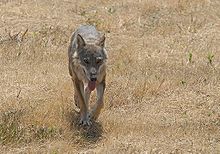Abruzzo, Lazio and Molise National Park
The Abruzzo, Latium and Molise National Park ( Italian Parco nazionale d'Abruzzo, Lazio e Molise ) is a national park in Italy . It has an area of 50,683 ha .
About three quarters of it is in the province of L'Aquila in Abruzzo , the remaining quarter is divided between the provinces of Frosinone in Lazio and Isernia in Molise . The national park administration is located in Pescasseroli in the province of L'Aquila. The Abruzzo National Park is the oldest national park in the Apennines and has played an important role in protecting endangered animal species such as wolf and brown bear. Most of the park is forested.
history
In the area of today's national park there was a royal hunting area since 1872. This was associated with protecting the game from all other hunters.
The national park was established in 1923. There are 25 parishes in 3 provinces on its territory, which led to considerable conflicts. After the state of construction was first recorded in 1955, it turned out in 1962 that in the past seven years, contrary to the construction bans in the national park, the villages had grown considerably. Not only private houses, but hotel buildings and other tourist infrastructure sprawled the valley areas around the settlement centers. In 1967 the environmental and cultural association Italia nostra presented a plan for how the park could be reorganized to create an economic basis for small, adapted businesses without destroying nature and the landscape. Antonio Cederna and Giorgio Bassani , the president of Italia nostra, are considered influential.
Due to the debate, a new director of the park was appointed in 1969, Franco Tassi. Tassi was a lawyer and associated with the conservation movement. He developed a new park concept that was implemented over the next two decades. The park has been decentralized; While all visitor facilities were previously in Pescasseroli , since 1970 there have been six visitor centers in all of the larger villages in the park. They have different focal points and each address regional characteristics. In addition, the tourist offers for the different seasons have been expanded. Until then, the facilities were based only on the travel habits of the upper classes in Italy and therefore extended almost exclusively to the months of July and August. Now various types of accommodation, from camping sites to family pensions to upscale hotels, have been promoted and local businesses and artisans have also been included in the concept of the park. A planned ski area was prevented and some illegally erected buildings were demolished where they could not be reconciled with the townscape and the landscape.
The new concept had success as early as 1973 and increasingly from the end of the decade. The number of visitors increased significantly and the smaller towns in the park came to life. The Civitella Alfedena particularly benefited. The region was a pioneer for adapted, natural tourism and became a model for other areas. In 1980 a zone concept was drawn up for the park, which extends in four zones from the total reserve to the development zone , in which careful settlement development is possible. In 2002, Tassi was deposed as director after the park developed a significant deficit as a result of cuts.
geography
The highest mountains in the park are the Monte Petroso with 2247 and the Monte Marsicano with 2242 meters. The “real ruler” of the park, however, is Monte la Meta .
The largest rivers in the park are the Sangro and the Diavolo . The Melfa , Giovenco and Volturno also flow at the park boundary . There are also a number of interesting natural lakes in the park: Lago Vivo , Lago Pantianiello and Lago di Scanno . Inside the park is the wetland of Lake Barrea , originally created artificially.
fauna

The standout attraction of the park is the European brown bear ( Ursus arctos marsicanus ). Until a few years ago, the brown bears were threatened with extinction here. According to official information, there are currently around a hundred bears in the park. However, Italian biologists estimate that the population does not consist of more than thirty individuals.
In addition to bears, there are a number of other large wild animals in the park, such as around 40 wolves . Other animal species are the European wildcat , the otter , the marten , the stone marten , the wild boar , the porcupine and the badger ; lynx are very rare . Foxes , rabbits , moles , hedgehogs and weasels can often be seen . Dormice and squirrels are also quite common .
Red deer and roe deer can be found in the forest areas thanks to resettlement . In the higher areas above the forests there are small populations of the Abruzzo chamois . Bird species found in the national park include golden eagles , goshawks , buzzards , eagle owls and tawny owls .
flora
In spring and summer, violets , crocuses , soldanels , gentians , lilies , anemones , primroses , ranunculus and many other types of plants bloom in the meadows .
Access
Pescasseroli in the province of L'Aquila offers the easiest access to the park.
Communities
The park is located on the territory of 25 parishes in three provinces:
activities
- Horse tours
- Trekking
- bike tours
- canoe
- Bird watching
- Cross-country and alpine skiing
literature
- Benno F. Zimmermann: Mountains and Bears. The Abruzzo National Park and its treasures . In: National Park . No. 139 , 2008, p. 8-13 .
Web links
- www.regione.abruzzo.it - Regione Abruzzo (Italian)
- www.parks.it - Parco Nazionale d'Abruzzo, Lazio e Molise (Italian, English)
- www.abruzzen-online.de - Abruzzen National Park
- World Database on Protected Areas - Abruzzo, Latium and Molise National Park (English)
Coordinates: 41 ° 46 ' N , 13 ° 52' E




